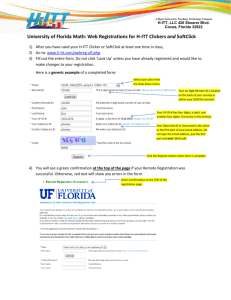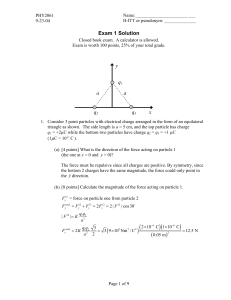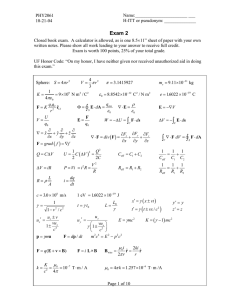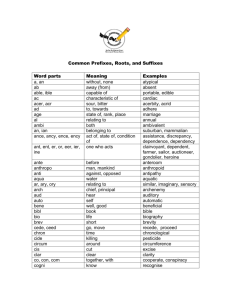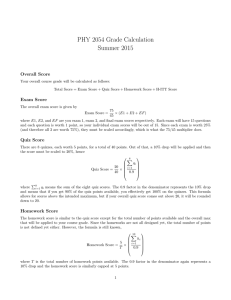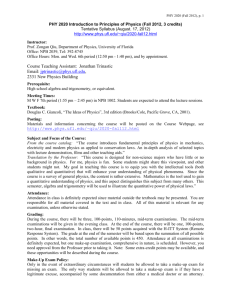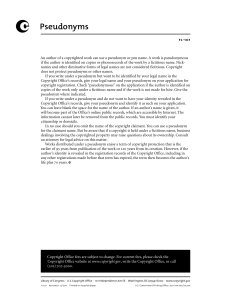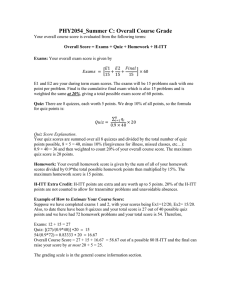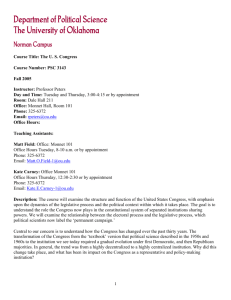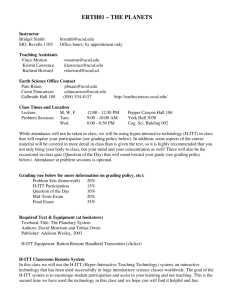Exam 1
advertisement
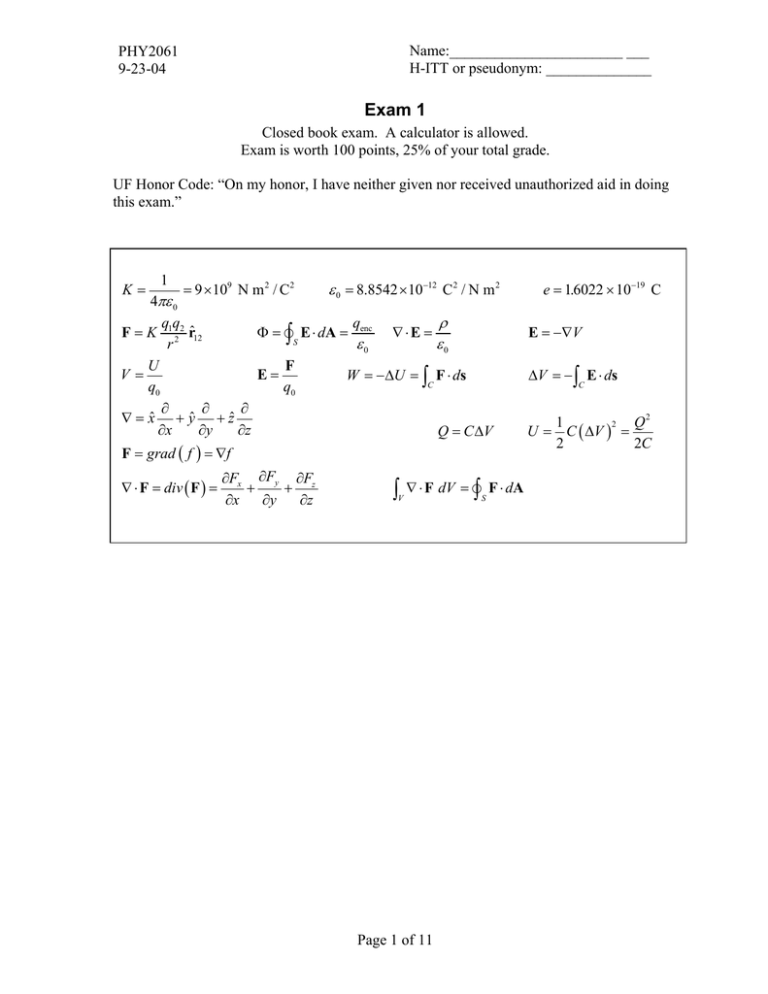
Name:_______________________ ___ H-ITT or pseudonym: ______________ PHY2061 9-23-04 Exam 1 Closed book exam. A calculator is allowed. Exam is worth 100 points, 25% of your total grade. UF Honor Code: “On my honor, I have neither given nor received unauthorized aid in doing this exam.” K= 1 = 9 ×109 N m 2 / C 2 ε 0 = 8.8542 × 10−12 C2 / N m 2 4πε 0 q qq ρ Φ = v∫ Ε ⋅ dΑ = enc ∇ ⋅ E = F = K 1 2 2 rˆ12 S ε0 ε0 r F U E= V= W = −∆U = ∫ F ⋅ ds C q0 q0 ∂ ∂ ∂ ∇ = xˆ + yˆ + zˆ ∂x ∂y ∂z Q = C ∆V F = grad ( f ) = ∇f ∇ ⋅ F = div ( F ) = ∂Fx ∂Fy ∂Fz + + ∂x ∂y ∂z ∫ V ∇ ⋅ F dV = v∫ F ⋅ dΑ Page 1 of 11 S e = 16022 . × 10−19 C E = −∇V ∆V = − ∫ E ⋅ ds C 1 Q2 2 U = C ( ∆V ) = 2 2C Name:_______________________ ___ H-ITT or pseudonym: ______________ PHY2061 9-23-04 y q1 a a q2 q3 x 1. Consider 3 point particles with electrical charge arranged in the form of an equilateral triangle as shown. The side length is a = 5 cm, and the top particle has charge q1 = +2µC while the bottom two particles have charge q2 = q3 = +1 µC ( 1µ C = 10-6 C ). (a) [4 points] What is the direction of the force acting on particle 1 (the one at x = 0 and y > 0)? (b) [8 points] Calculate the magnitude of the force acting on particle 1. Page 2 of 11 PHY2061 9-23-04 Name:_______________________ ___ H-ITT or pseudonym: ______________ 1. Continued: (c) [6 points] Calculate the electric field at the location of particle 1 arising from particles 2 and 3 ? (d) [6 points] Does a position exist where a fourth charge can be added to put the triangle in electrostatic equilibrium? If so, sketch where it would lie approximately, and write down an equation for its charge in terms of: the distance d from particle 1, the side length a, and the magnitude of the other charges (in other words, you don’t have to solve for d). Page 3 of 11 Name:_______________________ ___ H-ITT or pseudonym: ______________ PHY2061 9-23-04 y R x 2. Consider electric charge distributed along a one-dimensional path in the form of a semi-circle with radius R = 5 m in the upper two quadrants of the x-y plane as shown. The semicircle has a center at (x, y) = (0,0) and has a linear charge density of λ = +2µC/m. (a) [6 points] Find component of the electric field along the x-axis (Ex) at the origin (0,0). (b) [6 points] Find component of the electric field along the y-axis (Ey) at the origin (0,0). Page 4 of 11 PHY2061 9-23-04 Name:_______________________ ___ H-ITT or pseudonym: ______________ 2. Continued: (c) [6 points] If a semi-circle is added to the lower two quadrants (y < 0, with the center at the origin again) with a linear charge density of equal magnitude but opposite sign to the upper semicircle (i.e. −2µC/m), calculate the total Ex and Ey at the origin again arising from both semicircles. Page 5 of 11 Name:_______________________ ___ H-ITT or pseudonym: ______________ PHY2061 9-23-04 y x z 3. Consider a cube with side length s = 3.0 m and one corner at the origin (0,0,0) as shown. (a) [6 points] What is the total electric flux emanating out through the surface of the cube if the electric field is E = 15 zˆ N/C ? ( ẑ is a unit vector pointing in the z-direction.) (b) [6 points] What is the total electric flux emanating out through the surface of the cube if the electric field is E = ( 5 x 2 xˆ + 15 z zˆ ) N/C-m ? Page 6 of 11 PHY2061 9-23-04 Name:_______________________ ___ H-ITT or pseudonym: ______________ 3. Continued: (c) [6 points] What is the total charge enclosed by the cube if the electric field is the same as in part (b)? (d) [6 points] What is the electric charge density at the center of the right face at x = 3.0 m if the electric field is the same as in part (b)? Page 7 of 11 Name:_______________________ ___ H-ITT or pseudonym: ______________ PHY2061 9-23-04 y b a x 4. A very long cylinder (length L = 5 m) carrying a total electric charge of +5µC distributed uniformly along its length is surrounded by a concentric cylindrical shell with a total charge of −2.5µC distributed uniformly along its length as shown. The radius of the inner cylinder is a = 0.005 m and the radius of the outer cylinder is b = 0.01 m. (a) [6 points] What is the electric field strength and direction between the two cylinders (a<r<b) ? (b) [6 points] What is the electric field strength and direction outside the outer cylinder (r>b) ? Page 8 of 11 PHY2061 9-23-04 Name:_______________________ ___ H-ITT or pseudonym: ______________ 5. [4 points] The figure below shows an object made of an electrically conductive material with a total electrical charge +Q deposited on it. Sketch the electric field lines and equipotential lines near the surface of the object. Page 9 of 11 PHY2061 9-23-04 Name:_______________________ ___ H-ITT or pseudonym: ______________ 6. The surface of a conducting sphere of radius 5 cm is at a potential of 450 V with respect to the potential at infinity. (a) [6 points] What is the electric charge density on the surface of the sphere? (b) [6 points] What is the strength of the electric field at a distance of 10 cm above the surface of the sphere? Page 10 of 11 PHY2061 9-23-04 Name:_______________________ ___ H-ITT or pseudonym: ______________ (c) [6 points] If another sphere is brought in with a potential of −450 V at its surface with respect to infinity, what is the capacitance of the two-sphere system? Page 11 of 11
